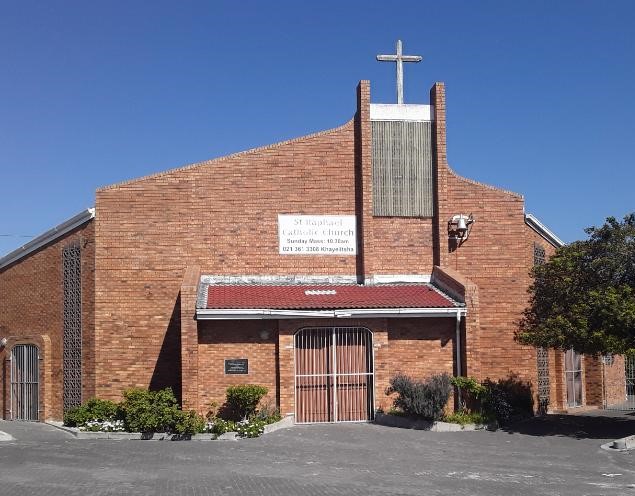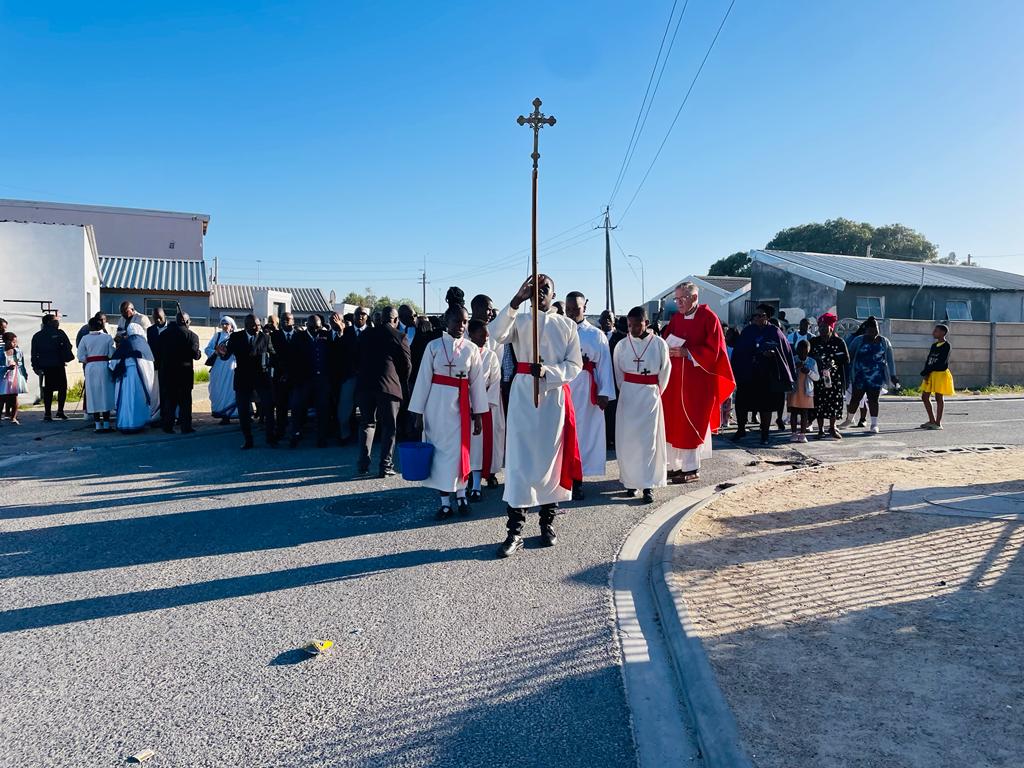Fr Pierre Goldie is the parish priest at St Raphael Catholic Church, Khayelitsha, Cape Town, and is an Associate Fellow of the KLC.

Typically, on Sunday morning, at 7.45am I drive from the Catholic parish church of St Raphael in Khayelitsha, Cape Town, to one of the two small “outstations” about five kilometres away, in a very urban, built-up environment, to celebrate my first Mass at 8.30am. As with every Sunday, I sense an aura of peace, serenity; a Sunday blessing of the Holy Spirit to an awakening world, and the streets, houses and shacks seem to be immersed in an early morning calm, grace, tranquillity. I return to St Raphael for the 10.30am Mass. The main church enjoys an attendance of up to two hundred on Easter Sunday; the other two stations, All Saints and St Therese, accommodate eighty-five and sixty, respectively.
We recall that in the apartheid regime, people were classified as Asian, Black, “Coloured” or White. In the Archdiocese of Cape Town, the racial split of the total number of Catholics is some 50,000 Blacks, 150,000 Coloureds and 70,000 Whites. This analysis is still of some relevance, as under the former apartheid regime, these groups were required to live in separate geographic areas, and they have some significant cultural differences. The allocation of quality of residence, education and work opportunities to each group was modelled by an apartheid mentality and favoured the Whites, then the Coloureds and finally the Blacks. The geography of where each group lives is still shaped by this former policy, as it will take time for an equitable allocation to result under the new dispensation.
The black towns are titled “townships,” a label which has a somewhat negative overtone, patent in cheaper construction and smaller units, alongside hundreds of thousands of shacks (or favelas as they are referred to in South America). Poverty is more prevalent in these townships and as poverty tends to breed dehumanized conditions, the crime rate is higher. The smaller houses also hail back to the apartheid days. Under apartheid, the white government of the Western Cape, where Khayelitsha and other African “townships” are located, did its best to keep Blacks from entering the province, but their efforts were not successful.
Even today, surely the biggest human migration in the world is taking place in Africa and South America, where people are flocking from the poorer country areas to the cities and bigger towns. Lima, in Peru, for example, has land invasions, crime, shacks (or favelas), great poverty, the ubiquitous minibus taxis, and struggles for water, sanitation, schooling for children, electricity (scarce for many) and jobs. This sounds just like Cape Town! Blacks have been steadily leaving the very poor Eastern Cape and settling in Cape Town and environs. The Industrial Revolution, especially the discovery of fertilizers, radically reduced the number of rural people needed to produce enough food for everybody. This is one reason for the extreme poverty in the country areas and the pressure to migrate to the cities.
“Blacks” in Cape Town refers mainly to the Xhosa and Sotho societies, a smaller portion of other indigenous peoples and a significant number of “Black” foreign nationals who have left poorer economies or internal conflicts to earn a living in South Africa.

My parishioners are largely Xhosa, but the number of Sothos has been increasing. For whatever reason the Holy Spirit has, I have felt a calling within a calling to work as a parish priest in the townships, hence my tenure in the Khayelitsha parish. I sympathize with the parishioners who have to put up with my dangerous pronunciation of Xhosa words, as I celebrate the Mass in isiXhosa. It’s a humbling (humiliating?!) task at times, to attempt to pronounce a word with up to twenty-two letters and ten syllables, but I do my best and I have never heard amused sounds or derisive comments. Perhaps, however, this is because of my insensitive, aging ears! At this stage, there are insufficient Xhosa priests in the Archdiocese to staff the African parishes, and in any event, Xhosa priests also serve in the other “Coloured” and White parishes, they are not confined to Xhosa parishes.
The parishioners are very accommodating, welcoming, accepting and hospitable, and many are doing the best they can for their children and grandchildren with substantially limited finances. They appreciate the effort of parish priests and support the parish financially. There are wounds of apartheid I detect amongst the Xhosa and Sotho people. My impression is of a deeply wounded dignity, sometimes a sense of inferiority, from people who have been given the lowliest residences, education and jobs, and who hail from a culture significantly different from the Western culture, with its own particular modes of operation. The situation is changing, nevertheless the wounds endure. Much healing is needed amongst all the former population groupings.
Again, I like to think, the Holy Spirit guided me to do some formal research in terms of a doctoral thesis which aims to discern the image of God as appropriated by the Xhosa Catholics, in relation to other sources of sacred power. I observe that Xhosa traditions have proved remarkably resilient, as well as that of other “tribes,” in all of South Africa.
Healing is a major category in the religious life of the indigenous people, who seek fullness of life, and answers to problems, health, immunity from evil spirits and witchcraft. This is evident amongst my parishioners. If this is not adequately provided for in Christianity or Western medicine, cultural solutions are pursued. They are socialized to seek healing from churches and traditional religion, not only secular health specialists. The migration from rural areas to the city can be said to multiply the number of problems that arise in the more complex, populated urban areas, and so every day, many black South Africans visit hundreds of thousands of healers of all types. The ancestor belief system remains robust, an enduring social and religious reality.
It was unrealistic of us Western missionaries to assume that proclamation would simply override the cultural patrimony of the indigenous people, especially when Christianity has failed to dialogue fully with culture, and to provide the answers the indigenous folk were seeking. The problem can be summarized as inadequate inculturation, lack of cultural awareness. While the indigenous people may feel comfortable with the dual religious system they abide by, some of the Christian churches perceive theological discord within this dual religious operation.
In contrast to the strong individualism of the Westerners, our parishioners are community-driven people, and believe that people are people through other people, a genuine relationship ontology. I have been told that when Africa is sad, Africa sings, and when Africa is happy, Africa sings. Thus it is difficult to persuade the choir to be subdued during the penitential seasons within the Catholic calendar! The unity of the people when singing and celebrating, is remarkable, as the congregation sings, sways and celebrates as a unified whole. Mission to Xhosas and Sothos in Cape Town is about one hundred and fifty years old, and is in response to Jesus declaring “Let us go elsewhere, to the neighbouring country towns, so that I can proclaim the message there too” (Mark 1:38).

The Kirby Laing Centre for Public Theology in Cambridge. Charity registered in England and Wales. Charity Number: 1191741
Kirby Laing Centre, The New Mill House, Unit 1, Chesterton Mill, French’s Road, Cambridge, CB4 3NP
© 2022 The Kirby Laing Centre for Public Theology in Cambridge